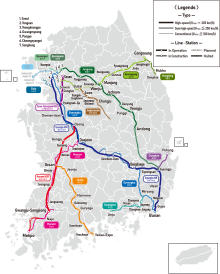
South Korea has a new and efficient high speed service known as Korea Train Express, abbreviated KTX. It is often promoted as an indigenous Korean train, although it is actually based on the French TGV.
Types of train and services
Most KTX trains leave from Seoul Station or Yongsan Station and terminate in the cities of Busan, Mokpo, Yeosu and Jinju. Most major cities are served in between. An additional line to Incheon International Airport has recently opened, allowing passengers to travel directly to other cities without having to change in Seoul Station any more.
The KTX train is regarded as an easier, more comfortable and cheaper way to get around South Korea than by plane. If you figure in security and getting to/from the airport it may also just be faster to go by train. Ticket prices are slightly below the equivalent airfare. The weekday price for Seoul-Busan is around ₩57,000.
There are two types of KTX service, KTX and KTX-Sancheon. The KTX-Sancheon uses newly built KTX-Sancheon trains, which have better seats and power plugs for travelers. There is no extra fare for KTX-Sancheon.
The KTX service does not connect to any other country, although many Koreans would hope that one day it could run through North Korea and onto the rest of the Asian continent. Plans by both South Korea and China to connect their networks through North Korea are unlikely to ever be fulfilled in light of the North Korean political situation.
Lines in service
Presently all lines start in Seoul and terminate in either the south west or south east of the country. A few trains continue past Seoul to Incheon International Airport. The mountainous north east of the country has no high speed rail coverage due to difficulty of track building and lack of economic activity to connect with.
- Gyeongbu KTX - Seoul-Busan
- Honam KTX - Seoul(Yongsan Station)-Mokpo/Gwangju
- Gyeongjeon KTX - Seoul-Jinju
- Jeolla KTX - Seoul(Yongsan Station)-Yeosu
Some trains proceed north from Seoul to Haengshin and Incheon International Airport.
Future lines
Note that the promised line from Incheon International Airport to Pyeongchang for the Winter Olympics in 2018 has been cancelled, although there are still plans to allow visitors to board a KTX train from the airport and still go to Pyeongchang on slower lines without changing.
A plan to build an undersea tunnel to Jeju island has been mooted by the government, with a KTX service taking just 2hours and 40 minutes to reach there from Seoul. Presently the Seoul to Jeju airline route is the busiest in the world, although construction would involve building the longest tunnel in the world and it is not clear if Korea would be prepared to invest the huge amount needed.
Booking tickets
Tickets may be purchased up to one month in advance at any Korean Rail station ticket office, or online at Korail's website. The online option has the benefit of allowing you to book in English, and tickets can be picked up in advance from any Korean Rail Ticket Office. However, you must bring your passport for identification when picking up the tickets.
Standby (입석, ipseok) tickets cannot be purchased online; those can only be purchased at ticket machines located at the major stations.
Residents in Korea have the option of purchasing tickets from the Korean-only KTX app. A Korean credit card is required.
Rear-facing seats will get 10% discount from the original price.
Be aware of Lunar New Year (late Jan or Feb) and Chuseok (Sep or early Oct) dates, as it is practically impossible to travel by train during these periods due to all the crowds.
